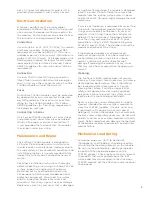
• Do not remove or modify any leads or
connectors provided with your module.
Doing so could result in electrical shock,
arcing, and fires as well as void the module’s
warranty.
• Use only MC4 connectors from Multi-
Contact when connecting to these modules.
• When cutting the wire tray, use all relevant
personal protections equipment per OSHA
guidelines. Cut the tray and cover prior to
installation and away from modules and the
roof surface to prevent accidental damage
to those components.
5
Handling Safety
• System designers and installers are
responsible for proper support structure
design. Sunflare is not responsible for
supporting structures, including but not
limited to the roof structure.
• Follow all local, regional, and national
statutory regulations and obtain all required
building permits.
• Only use equipment, connectors, wires, and
support systems suitable for solar electric
systems.
• Do not lift or carry the module by its junction
box or electrical leads.
• Do not stand or step on the module until they
are fully installed.
• Do not stand or walk on modules unless they
are clean. Dirt and debris underfoot could
cause damage to the surface of the module
reducing its electrical performance.
• Do not drop the module or allow objects to
fall on the module.
• Do not place heavy or sharp objects on the
module.
• Use only original packaging when
transporting or moving the modules.
• Do not disassemble the modules or
remove any nameplates, serial numbers, or
components from the modules.
• Do not apply paint or adhesive to the
module.
• Do not modify the module in any way.
Unique Identifier
A record of the modules serial numbers should
be made before installation and this should be
included in the system documentation to be saved.
The module’s serial number is located on the back
of the module near the name plate and on the
front side of the module on the top right next to
the j-box. The serial number contains the factory
identifier, date code, and a unique identifying
number as shown in the example below:
• Warning!
Do not scratch, hit or damage
the topsheet or the backsheet in any way.
Damage to these components could create an
electric shock hazard.
• A panel with a damaged or torn topsheet or
backsheet cannot be repaired and must not
be used.
• Work only under dry conditions, and use only
dry tools. Do not handle panels when they are
wet.
• Danger!
Keep uninstalled panels in their box
until it is time to install them. Make jumper
connections to the J-boxes immediately upon
installation to keep water and debris from
penetrating the j-box connectors. If immediate
connection isn’t possible, take measures to
prevent water and dirt from entering the j-box
connectors. Failure to protect the electrical
connections could result in electrical arcs
leading to fire and possibly shock hazards.
• Danger!
All electrical contacts should be kept
dry and clean. Failure to do so could lead to
electrical arcs resulting in fire and possible
shock hazards.
• Keep all connectors and wires away from the
roof or any area which may collect water.
• Modules should not be subjected to
concentrated loads or stresses during or
after installation other than those from
environmental factors such as wind and snow
loads.
• Warning!
Do not attempt to roll or fold the
modules. Doing so could result in internal
electrical damage leading to arc faults and
fires.

































